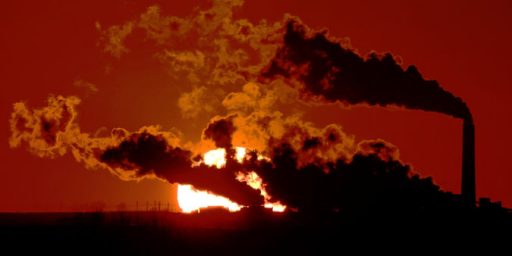Another Report on the EU’s Carbon Trading Nonsense
Confirming that cap-n-trade programs are going to be difficult at best, if not outright impossible to implement, or why Kyoto and all the wrangling and arguing over it is a big waste of time we have this article from the Guardian that the EU’s carbon trading scheme has been little more than a colossal waste of time.
Brussels lambasted the US and Australia yesterday for their inaction in cutting carbon dioxide emissions and stressed Europe’s leading role in the battle against global warming. “Only EU leadership can break this impasse on a global agreement [post-Kyoto] to overcome climate change,” Stavros Dimas, the EU’s environment commissioner, told scientists from the UN’s intergovernmental panel on climate change. The body is due to publish a report this week in Brussels on the impact of global warming.
Uh-oh, maybe not.
What Mr Dimas knew – but did not tell the scientists, apparently – is that the EU’s programme for cutting carbon, its two-year-old emissions trading scheme (ETS), remains in disarray.
[…]
However, preliminary data on the scheme’s performance last year – its second year of operation – showed that 93%, or about 9,000 of the 10,000 heavy industrial plants covered by the EU’s trading scheme, emitted less carbon than their quota of free permits. The resulting 1%-1.5% rise in emissions was not as great as in 2005 but the spot price of a tonne of carbon fell by about a quarter to €1 (68p), at one point collapsing to just 92 cents.
Only a handful of countries shored up the market by issuing fewer emissions quotas than industry wanted. These included: Britain – where Drax, Europe’s biggest coal-fired power plant, emitted 5m tonnes more than its 15.5m tonnes permit – Denmark, Ireland, Italy and Spain. The trading mechanism is designed to create scarcity, forcing up the price of carbon and prompting industries such as steel and power generation to invest in cleaner, greener technologies, such as renewable, carbon-free energy and, eventually, carbon capture and storage. So far, it is manifestly not working as planned.
[…]
Mr Dimas and his officials deliberately released the raw data early – without analysis or interpretation – to avoid last year’s debacle, when premature release of national statistics brought a disorderly collapse of the market. This year the full, sifted figures will be released on May 15.
The 2005 data showed that industry emitted 66m tonnes less carbon than allowed, prompting allegations that, in Germany alone, the four big power producers had enjoyed windfall profits of up to €8bn by cashing in their excess free carbon permits. In Britain, despite the tighter cap, generators are estimated to have made £1bn.
Whew. Saved by the idiocy of Euro-weenie politicians and their spinelessness. I have to hand it to them, designing a cap-n-trade program where the companies actually generate windfall profits. Brilliant…absolutely brilliant. That is if you want to ensure that companies go right on emitting lots of CO2 and delaying, possibly for years, the implementation of cleaner energy generating technologies. And here politicans like Satvros “Dimbulb” Dimas labastes the U.S.
To be clear here, if there are so many permits out there that firms do not have to use them, then there are way, way too many permits. The idea behind a cap-n-trade system is to create a market where one did not exist previously and to set the supply to internalize the external costs. In this case, emission of CO2 is the externality that needs to be reduced. But when the market is basically flooded with permits there is no need to curtail emissions and basically you have a bureaucrat employment program that you call a cap-n-trade program.
Of course, there are the usual claims that next time they’ll get the number of permits correct and there will be far fewer and firms will want to reduce emissions. At this point, I’ll believe it when I see it. After all, all those billions in windfall profits will mean that carbon emitting firms and industries will have all that much more incentive to keep things going as they are.






I have a real, sincere, non-snarky question. Why is it better to agree to something and then fail to achieve anything by your efforts than it is to reject the agreement outright?
Because the agree then renege allows you to take a morally superior position and denigrate others. Granted, technically you are no better, and probably worse than those who reject outright, but when has that ever stopped sleazy politicians?
“there are the usual claims that next time they’ll get the number of permits correct and there will be far fewer and firms will want to reduce emissions. At this point, I’ll believe it when I see it.”
They’ve already agreed most of the caps for the next phase. And they’re well below the last permit levels.
So they’re trying something new, have checked the results of the inital attempt and are adjusting accordingly.
Gosh, how spineless……..
“Euro-weenie ”
? What’s that supposed to mean ?
Kenny,
Did you get that pony for your birthday too?
Sheesh are you gullible.
“Did you get that pony for your birthday too?
Sheesh are you gullible. ”
You mean they way they’re following the exact same process as they followed when they set up the existing caps, only this time with the experience gained from the first time they’re cutting the capping level below where they set first time out ?
These caps aren’t suggestions or hints. They’ve been agreed to under a legally binding treaty.
Obviously I’m not the only gullible one. The article you link to notes that the current price for a tonne of carbon in December next year when the new caps come in is trading at 17 euros as compared to 0.92 euros for december 2007.
Kenny,
Your idea that they made a mistake, learned from it and will correct for it is laughable. They already knew how much they needed to reduce CO2 by and thus how many permits they needed. It isn’t that they misguessed because firms voluntarily cut back, but because the politicians didn’t want pissed off voters due to higher energy bills.
Riiiiight. They have had two years to get this right, but the third time’s the charm I guess.
I am replying to Michael who make a comment too late for me to respond to, on Steve’s last warming post.
Michael: I am thinking of the last ice age. I do believe that huge areas of North America, and less importantly S. America, were covered with ice sheets and snow for many thousands of years. It seems to me that much carbon has since been stored in these locations.
By my reckoning we still have some room left, there, for another 50-100 years of catch-up, at present rates of use carbon release: That is to say, more real estate to store carbon naturally.
Also, at present use, we should be able to store another 500 Gt carbon, in the biosphere, as the globe warms from the additional energy we get from the warming Sun.
All in all I see no problem waiting another 50-100 years before undertaking any hand-cuffing of one another.
“Riiiiight. They have had two years to get this right, but the third time’s the charm I guess.”
Ah. i do apologise.
I actually thought you knew what you were talking about.
The initial regime was brought in to cover a 3 year period (2005-2007).
The 2nd phase covers 2008-2012.
They couldn’t change the caps until the 2nd phase because it’s not an annual arrangement. The caps cover the length of the phase.
Clearly as you weren’t aware of this you were in fact talking from a position of ignorance.
Fine, i’ll remember that the next you post anything about the EU-ETS scheme.
I note you don’t explain why if i’m gullible the price of a CO2 tonne is 17 euros next year….